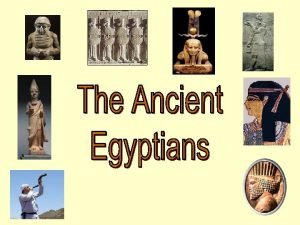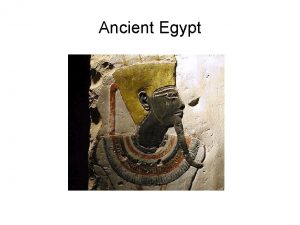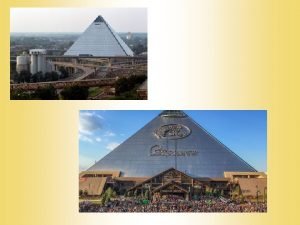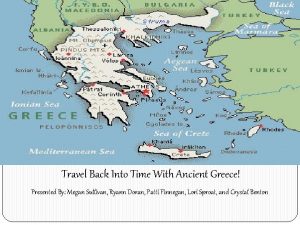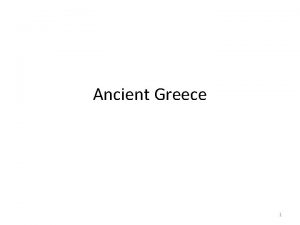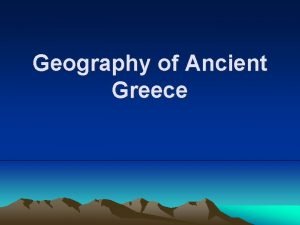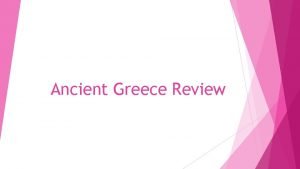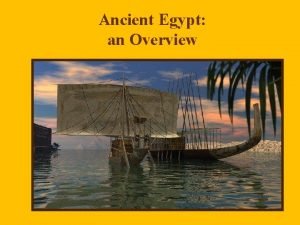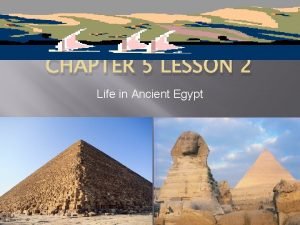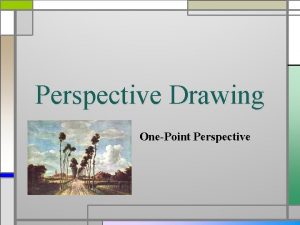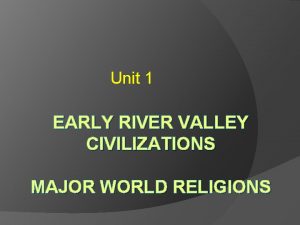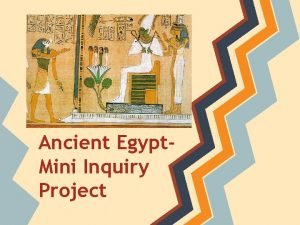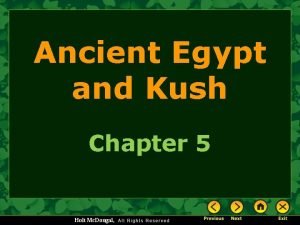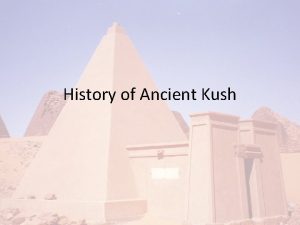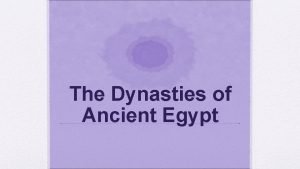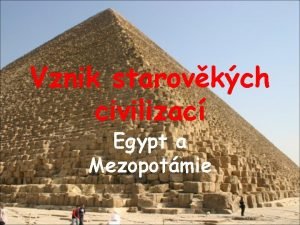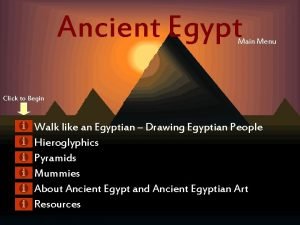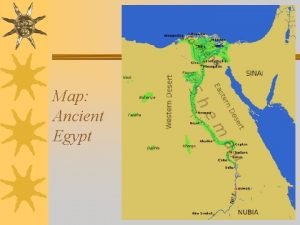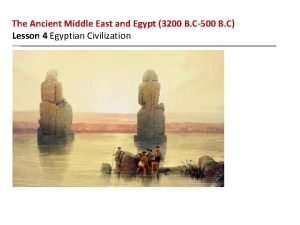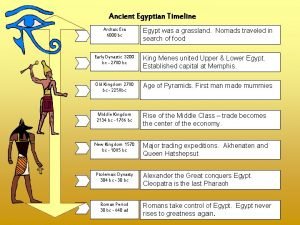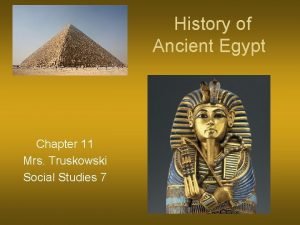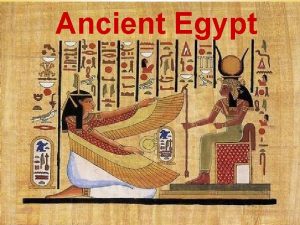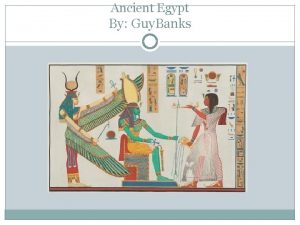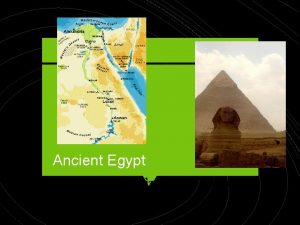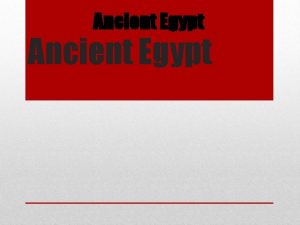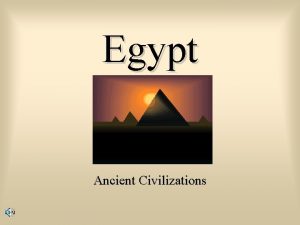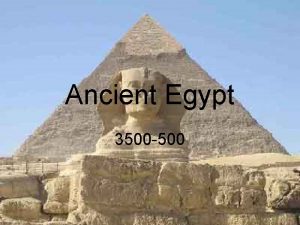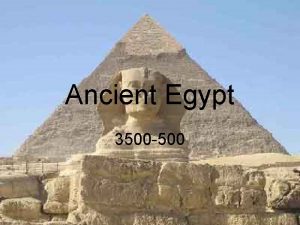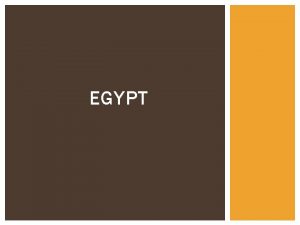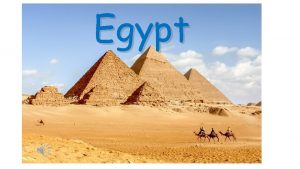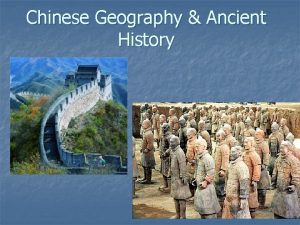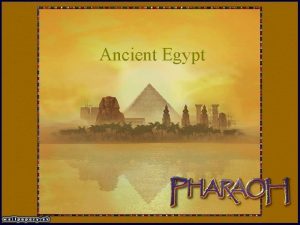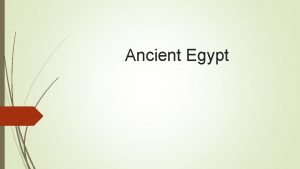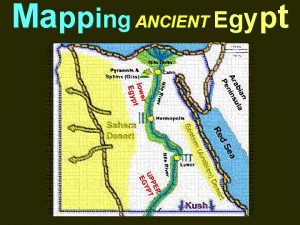Ancient Egypt an Overview Geography Egypt is located































- Slides: 31

Ancient Egypt: an Overview

Geography • Egypt is located in northeastern Africa • The Nile River runs the length of the country flowing south to north • The river begins in the mountains of Africa and empties into the Mediterranean Sea • The climate is hot and dry, part of the Sahara Desert http: //www. worldcountries. info/Maps/Google. Map-Egypt. php http: //www. ancientegypt. co. uk/geography/explore/ter. html


Geography • Ancient Egypt was divided into two regions: Upper and Lower Egypt • Lower (northern) Egypt consisted of the Nile River's delta made by the river as it empties into the Mediterranean. • Upper Egypt was the long, narrow strip of ancient Egypt located south of the Delta. http: //www. ancientegypt. co. uk/geography/home. html



The Nile River • The Nile was the lifeblood of ancient Egypt • It made life possible in the otherwise barren desert of Egypt. • It is the longest river in the world (over 4, 000 miles). • It served as a source of food for the people of ancient Egypt • It was the major source of water for bathing and drinking • The Nile was crucial for farming



Blue Nile

White Nile

White & Blue Nile Meet in Sudan

Floodplain

Floodplain • The low strip of fertile land located on either side of the Nile River • The river flooded during the annual inundation • When the inundation subsided, it left the earth soaked and overlaid with a fresh layer of black silt. • Most of the farming occurred here

Nile Delta • Located in northern Egypt where the Nile River spreads out and empties into the Mediterranean Sea • 240 km of coastline, 106 km in length • Rich agricultural region • Most fertile soil in Africa


Great Sahara Desert

Bordered on the south, east and west by the Sahara Desert, and on the north by the sea, ancient Egypt was protected from outside influences.


Facts About the Nile River Length 4, 184 miles 2 Sources Lake Victoria, Uganda (White Nile); Lake Tana, Ethiopia (Blue Nile) Mediterranean Sea, off Egypt Mouth Countries Egypt, Sudan, Uganda, Ethiopia, Flows Through Zaire, Kenya, Tanzania, Rwanda, Burundi Name Origin Greek word Nelios, which means "River Valley"

Religion • Belief that many gods and goddesses ruled the world and the afterlife Amon-Re: sun god Osiris: god of the underworld and of the Nile • The pharaoh was believed to be a god as well as a ruler Falcon Headed Sun God

Religion • Belief in eternal life after death. Relied on the Book of the Dead to help them through the afterworld. • Practiced mummification, the preservation of the body for use in the next life.

Book of the Dead Collection of spells, hymns, and prayers intended to secure a safe passage to the underworld for the deceased

Writing Making paper from papyrus

What is hieroglyphics? • Hieroglyphics is the picture writing used in ancient Egypt. The word hieroglyphics is made up of two Greek words - hieros, which means sacred, and glyphe, which means carving. • The Egyptian hieroglyphic writing system consists of several hundred picture signs. The signs can be divided into two classes, phonograms and ideograms

Phonograms represent sounds, much as alphabet letters do. Ideograms are signs that represent whole words or concepts.

Pyramids

The Great Sphinx

Mythology Egyptian goddess Isis, tomb painting, ca. 1360 BC.

2 Social Classes PHARAOH Earthly leader; considered a god HIGH PRIESTS AND PRIESTESSES Served gods and goddesses NOBLES Fought pharaoh’s wars MERCHANTS, SCRIBES, AND ARTISANS Made furniture, jewelry, and fabrics for pharaohs and nobles, and provided for other needs PEASANT FARMERS AND SLAVES Worked in the fields and served the pharaoh

Daily Life The Egyptians - Daily Life in Ancient Egypt
 Ancient egypt civilization geography
Ancient egypt civilization geography Disadvantages of ancient egypt geography
Disadvantages of ancient egypt geography Upper egypt and lower egypt
Upper egypt and lower egypt Where was ancient greece located
Where was ancient greece located Where was ancient greece located
Where was ancient greece located Old greek map
Old greek map Which continent is ancient greece located
Which continent is ancient greece located The rise of greek civilization *
The rise of greek civilization * Egyptian floral design
Egyptian floral design Egypt 3 kingdoms
Egypt 3 kingdoms Egyptian social pyramid
Egyptian social pyramid Ancient egyptian caste system
Ancient egyptian caste system Chief god of egypt
Chief god of egypt Ancient egypt
Ancient egypt Ancient egypt civilization
Ancient egypt civilization Economy of ancient egypt
Economy of ancient egypt Specialized jobs in ancient egypt
Specialized jobs in ancient egypt Ancient egypt medicine
Ancient egypt medicine Trophic level
Trophic level Kalasiris egyptian clothing
Kalasiris egyptian clothing Ancient egypt and kush map
Ancient egypt and kush map Map of ancient cush
Map of ancient cush Ancient egypt bell ringers
Ancient egypt bell ringers Ancient egypt vocabulary words
Ancient egypt vocabulary words Achievements of ancient egypt
Achievements of ancient egypt What is frontalism
What is frontalism Ancient egypt vocabulary words
Ancient egypt vocabulary words Ancient egypt map
Ancient egypt map Egyptian hierarchy
Egyptian hierarchy Egyptian religion timeline
Egyptian religion timeline Ancient egypt timeline
Ancient egypt timeline Ancient egypt non chronological report
Ancient egypt non chronological report
